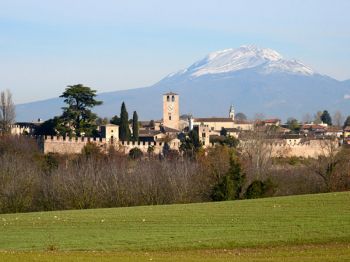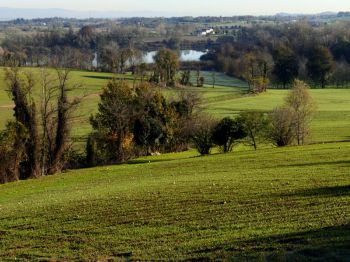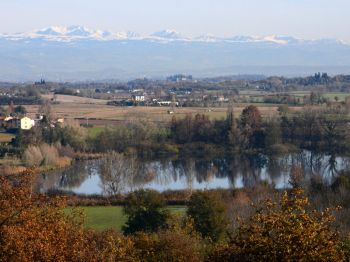Castellaro Lagusello Nature Reserve
The ancient medieval village with the beautiful walls overlooks a small heart-shaped lake. An itinerary realized by the Park following both dirt roads and wooden paths leads to approach the wetland. Other routes can be covered on foot on dirt roads towards the area of Mount Tondo, or along the paths entering the downy oak and turkey oak forests. In the village's bell tower a small space with information panels has been organized to show the particular mosaic of habitats present in the area. In the villages it is also possible to enter the private castle to walk on the surrounding walls.
The SCI (Site of Community Importance) "Moraine Complex of Castellaro Lagusello" extends over a surface of about 271 hectares in the territories belonging to the municipalities of Mozambano and Cavriana: it is situated in the central part of Garda's moraine amphitheater and consists of low and rounded hills, in the area between the Garda lake and the plain. In the valleys among the moraine hills there are wetlands or small water expanses, such as the beautiful heart-shaped small lake of Castellaro.
The water flows away from the lake through the Fossa Redone Inferiore, which goes round the western side of the village of Castellaro Lagusello and enters the Torbierina, flooding the holes of the old peat quarry. The Giudes wetland is situated less than 1 km from the lake in a south-west direction. Another karst spring can be found near the Le Colombare farmstead. The site completely includes the Castellaro Lagusello Moraine Complex Regional Nature Reserve, affecting the small lake, the surrounding wetland and the hill area of Mount Tondo, on a total surface of 138.6 hectares.
Flora
The dry slopes of the moraine hills around the Garda lake host xerophile forests and meadows. The forests are characterized by the presence of the turkey oak and the downy oak. In the upper layer there are the hop hornbeam, the black locust, the European nettle tree, while in the lower one there are the medlar tree, the common hazel tree, the Cornelian cherry tree, the field maple, the wild privet, the common hawthorn and the common dogwood. In the wood situated on the left of the road leading from the village to the Corte Casino, it is worth seeing the widest population of grass-leaved flag in the hills around Mantua. In a deep canal marking the borders of the forest two orchid species grow: the common twayblade and the lesser butterfly-orchid. In the lake and in the Torbierina the yellow water-lily, the water-lilies and the long root smartweed prevail. Along the ditches merging into the lake, or in the ditch around the lake, there are the common water-crowfoot and the water violet, a very rare plant belonging to the Primulaceae family.
The groves of reeds enclose most of the lake and of the Torbierina, while the sedges usually grow in the southern shore of the lake, where the narrow sedge and the shore sedge prevail.
Between the sedges and the lake there is a black alder hydrophilic forest, with white willows, black poplars and grey willows. In the site there are 12 bird species of community interest, 3 of which are nesting species.
Fauna
In the site there are 99 bird species divided into non-migratory, migratory and wintering species. The most significant species are the little bittern, the common kingfisher - which usually inhabit the lake especially in its southern side, where the shrubs offer useful roosts to dive from - and the European bee-eater, which nests on a side overlooking the peat bog's eastern side. Two amphibian species of community interest have been found here: the Italian agile frog, a very rare endemic species, and the northern crested newt. Among the 214 registered invertebrate species it is worth mentioning the Lucanus cervus, a beetle connected with the dead wood of the oak forests, and the large copper.
Castellaro Lagusello
(foto di Archivio Parco Mincio, BAMS Photo)

Castellaro Lagusello
(foto di Stefano Mariga)

Castellaro Lagusello Nature Reserve
(foto di Stefano Mariga)

Castellaro Lagusello Nature Reserve
(foto di Stefano Mariga)

